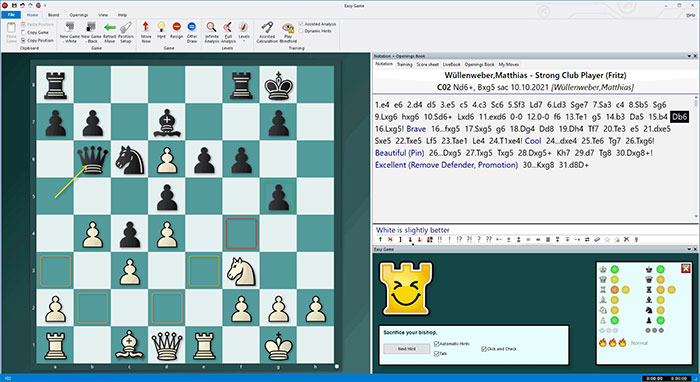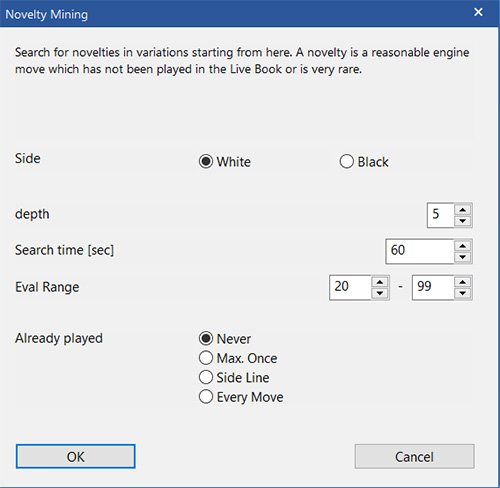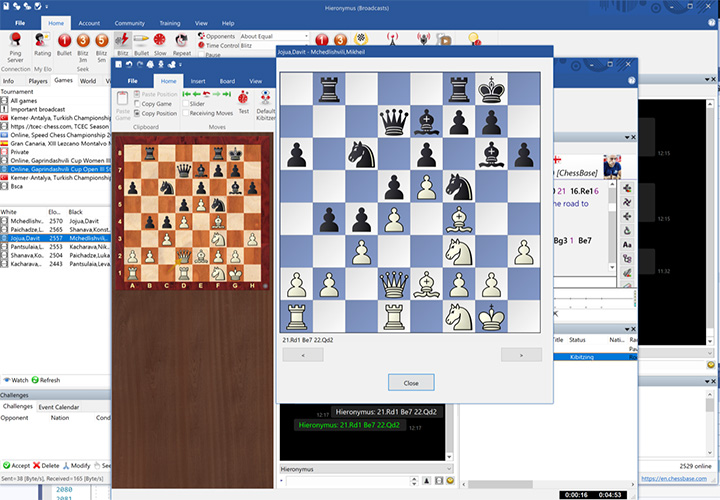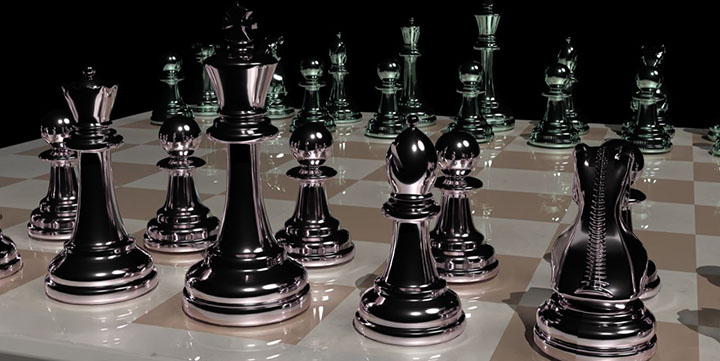Fritz 18 offers you the chance to discover a new you in terms of chess playing. “Evolving Genius” is a completely innovative training method, with which when playing against Fritz you learn more than just to attack. You will be astonished at what you find in yourself! You will never have won such nice games against Fritz!

This is possible because Fritz 18 intelligently organises its play and leads you through the game with the help of subtle tips. As soon as Fritz comes under pressure, as a defender it will prefer variations which provide for you, the attacking side, good chances of a sacrifice or other tactic. That often permits spectacular attacking victories. Against Fritz18 you will manage sharp wins such as have not been possible in 40 years of chess programming.
However, the decisive question is the following: how do you bring about the setups in which attacking chances then crop up? Quiet, positional systems more rarely lead to success, although here too Fritz manages to incorporate hidden mistakes. Over time you develop a feeling for how to reach positions in which threats against the king are in the air: you learn to attack better. For myself, at least against Fritz 18 I have switched my repertoire completely from 1.d4 to1.e4. To shorten this learning process for you Fritz 18 contains a repertoire for White with which you can get into promising positions more often.
In general in the “Evolving Genius” mode on the “Club player” level, Fritz does play in a restrained manner, but nevertheless strongly. The games should not be too simple. Nevertheless, it is possible to win very often. For that there are considerably improved subtle hints. You determine the major part of the game yourself, but when you are facing a headwind you can summon help. Imagine an E-Bike: according to how good your performance is you can switch on the support of the motor, but it is still cycling. Examples of subtle hints from Fritz18: “Attack a minor piece”, “Occupy a strong square”, “Threaten mate”, “Win material”, etc.
Visual evaluation

Users keep on asking us whether the engine output in infinite analysis could not provide more information than only main variations and evaluations. For that reason, Fritz18 now shows a visual representation of important parameters of the position:
- Well and badly placed pieces on a colour scale from red (bad) via yellow to green (good). Included in this evaluation are pawn structure and king safety.
- Activity and coordination of all pieces graded in five levels.
- Complexity and sharpness of the position graded in six levels
This visual evaluation is calculated for the current board position and is instantly available for any move in the notation with a click of the mouse.
New analysis functions in the engine window
If the engine is analysing in multi-variation mode, at the start of the calculation additional information is provided which provides exciting additional insights:
- Obvious alternatives along the line of “Why does … not work?”.
- Interesting threat if one is present.

Of course it was also possible previously to access this information with skilled handling. But now it is actively offered and leads to additional ideas and possibly a better understanding of the tactical motifs present. It is not everybody‘s cup of tea to picture in their head long engine variations. In Fritz18 you just hold the mouse pointer over a move in the variation and the relevant position remains on the board until the mouse leaves the area.
New board
The present Windows variations have available with Direct2D a powerful interface for rapid on-screen representations. There was the opportunity to use it to realise a new graphic chess board. The fresh new look of the pieces is obvious, but the new technique allows other subtleties e.g. highlighting the pieces by having them glow or decent animation of captures.
New in FRITZ 18:
- Intelligent tips: Fritz provides subtle hints in difficult positions
- Visual evaluation: pawn structure, king safety, piece activity and sharpness of the position
- New chess board in Direct2D technology with a fresh look and improved animation
- New engine analysis: Interesting threats, appealing ideas and the game continuation
- Animated engine variations: Intuitive visual display of the best continuation
- Improved calculation training to give your Elo a quick boost.
- Stronger Fritz 18 engine by Frank Schneider, optimised for short time control
ChessBase 16
What you can do with ChessBase:
Retrieve games according to openings, players and tournaments; generate tournament cross tables and full graphic statistics of players or openings; “Similarity search” shows all games with similar pawn structures, sacrifice patterns, endgame positions, etc.; “Let’s check”*: access the world’s largest database of in-depth analysis (more than 200 million positions); “Instant Analysis”: Any unannotated game is analysed almost without delay immediately on loading (optional). “Assisted Analysis”: as you enter a game, whenever you click on a piece an evaluation is produced for all its possible target squares; “Tactical Analysis” will annotate game, inserting commentary, variations and diagrams, before strong moves or errors, into a game or an entire database. It will also point out combinations, played in the game or missed, tries, attacks, initiative, and of course the latest in openings theory; Cloud analysis: you can analyse positions simultaneously with several engines from on different computers running in parallel; “Deep analysis”: generates an analysis tree that changes dynamically, as with time weaker variations are dropped; automatic analysis jobs for correspondence games; “Replay Training”: Playing through a game with the notation hidden and automatic training questions with tips for each individual move. Extended reference search for openings shows increase/decrease in popularity and typical recurring endgames; merge games on the fly into an opening tree; generate a dossier containing all available information on a specific player from the database; generate a comprehensive openings report with main and critical lines, plans and most important games; single click publication of games on the Internet; Improved search mask with tactical motifs and examples for manoeuvres and material distribution; Completely new search booster for patterns and plans; print games in superb quality with diagrams and multiple columns; Crisp new 3D boards thanks to raytracing technology; automatic update of your local reference database with the weekly installments of games (one year); access to the ChessBase online database with over eight million games*; mobile access with the ChessBase Account*.
New features:
Automatic opening surveys
The central new function in ChessBase 16 consists of automatic opening surveys for any move whatsoever. Until now opening preparation was above all about move selection. With the traditional tools such as LiveBook, Reference and Online Database, however, one’s attention is strongly concentrated on only the next move. It is much more effective to have a variation tree, an opening survey. ChessBase now provides that. At a glance you will see the complete opening in front of your eyes and you can immediately evaluate which variations are important to master safely. This ready survey can perhaps be supplemented by material you have prepared yourself and thus quickly becomes part of your own repertoire. But how is the move selection made? That may happen through an algorithm, but it is you who set the parameters, the style of the opening choice. To set it there is the choice between Main Lines – Fashion – Side lines – Gambit – Attack – Positional and Endgame. I would like to briefly present some of the styles which are perhaps most important for your practice.
“Fashion”. In it moves are selected which dominate modern practice. This often results in considerable deviations from the traditional main variations and delivers the most interesting and theoretically best founded survey. For the time-poor practician we recommend the “Side lines” style. Just as on a Google search we usually click only on the top links, in opening preparation too those moves which are frequently played and at the top of the list exercise a magnetic attraction. Like this, very playable secondary systems are overlooked through which passable positions can be reached and which demand little preparation time. There is a somewhat flashy opening survey in “Gambit” style, which takes into account any half-way playable sacrifice. Almost every one of the known gambits in chess theory will certainly show up in these surveys. Then we also have the style “Attack”. It searches in respectable recent games for the sharpest continuations possible. That leads to very aggressive secondary systems, e.g. often with an early h2-h4. When you wonder: “Who plays something like that?”, the answer is quite often “Magnus Carlsen”.
The search is based on your own reference database, thus best of all the latest Mega Database including the online updates. If someone else with a reasonably up-to-date reference database has already looked at a survey from that particular move it (while adjustable) comes directly from the server and thus is ready immediately.
Smooth handling of deep variation trees
Opening surveys with deeply nested variations make particular demands on the representation of the notation. For that reason ChessBase 16 possesses a new way of “folding” variations which can be opened or closed simply with a click of the mouse. Another novelty is the automatic recognition of games quoted. All the opening surveys of ChessBase 16 contain pointers to recent strong sample games.
Real time notifications of interesting opening trends
The tactical analysis for automatically commenting on games is extended by means of particular opening comments. ChessBase 16 recognises whether an innovation is important and comments appropriately. Furthermore, hints are provided to recent theoretical trends and successful secondary systems.
Further innovations in brief
Update of Mega database with one click. Improved search booster with a need for half the space on your hard disk. Link to ChessBase Shop with direct installation of purchased products. Preparation for opponents with spotting of weaknesses based on your own repertoire. Search for characteristic tactical positions in an opening variation.
New in ChessBase 16
- Opening surveys for every move with a single click. With a choice of focus: Main Variations, Fashion, Side Lines, Attacking, Gambits, Endgame
- Better overview when playing through deeply analysed games thanks to dynamic folding of the notation
- Urgent news about recently played innovations with direct access to the database
- Direct database access to tournaments being played live
- Preparation for opponents with recognition of their weaknesses taking into account your own repertoire
- Innovations and trends as annotations in Tactical Analysis
- After an update to Megadatabase, overview of important recent innovations and theoretical trends.
- Tags for the management of games.
- Search for characteristic tactical positions in an opening variation
- Link to the ChessBase Shop with simple installation of purchased download products
- Slimmed down search booster: required hard disk space halved
- Playchess chat modernised














